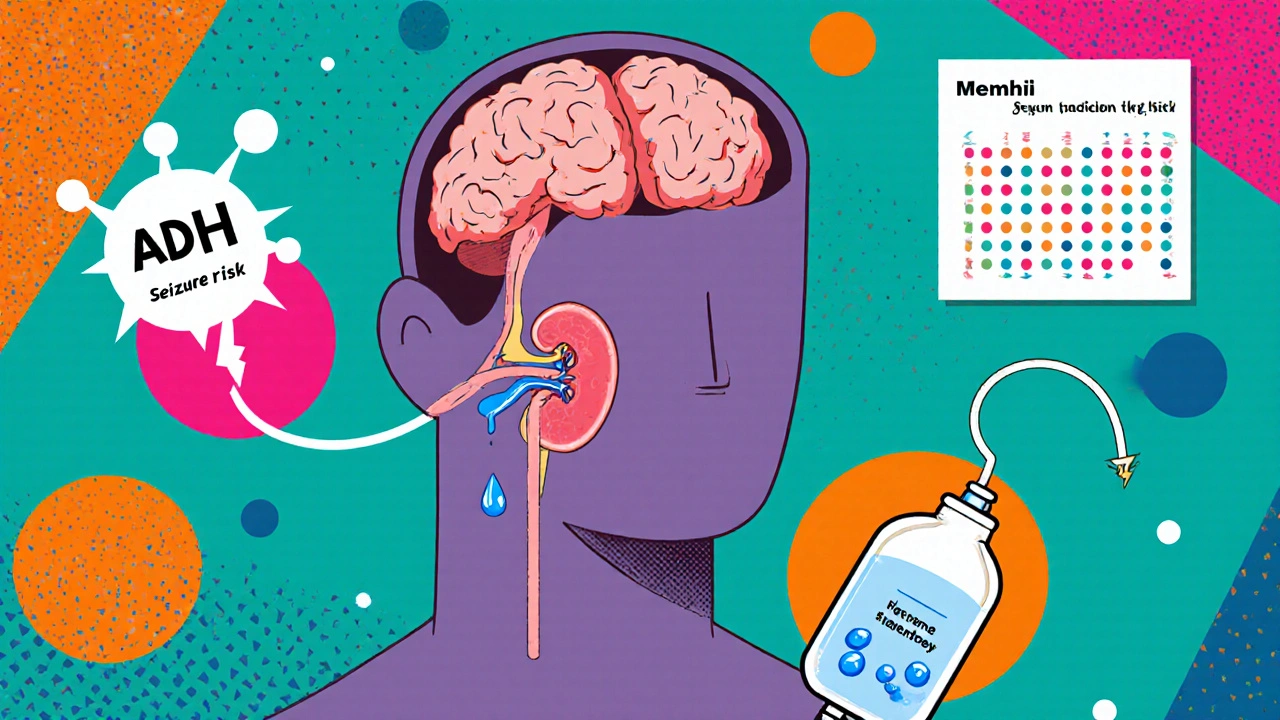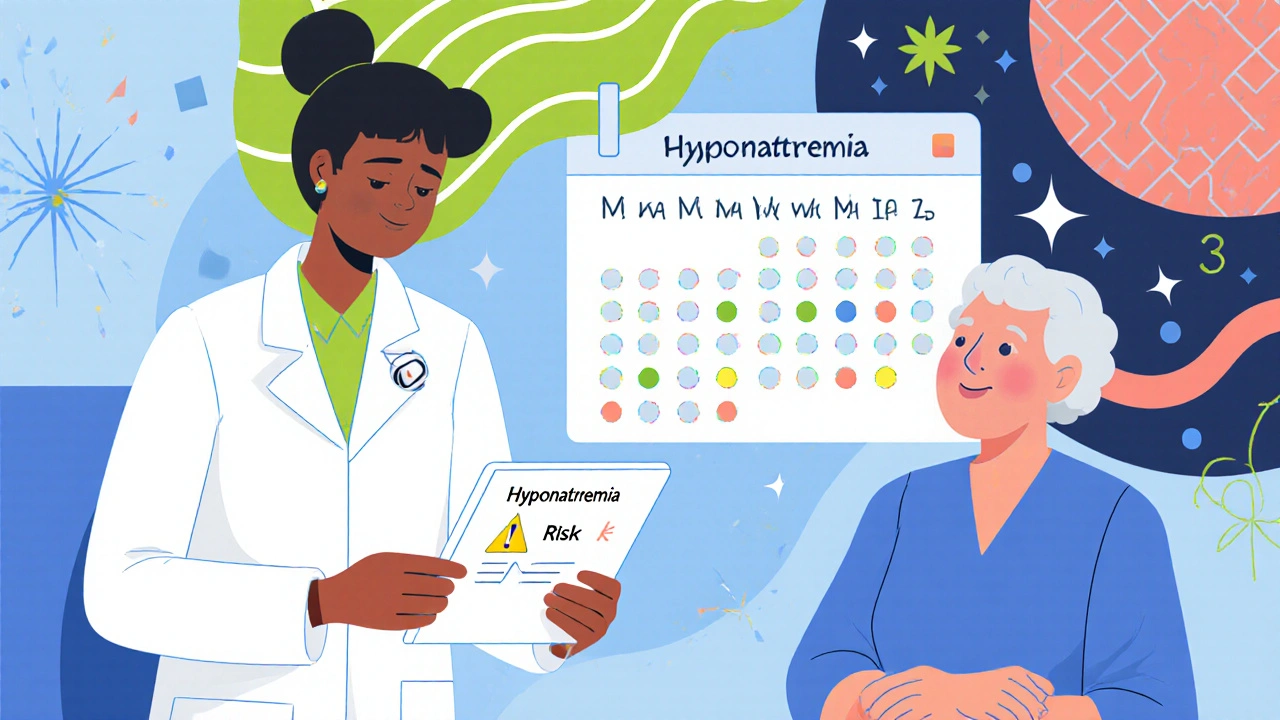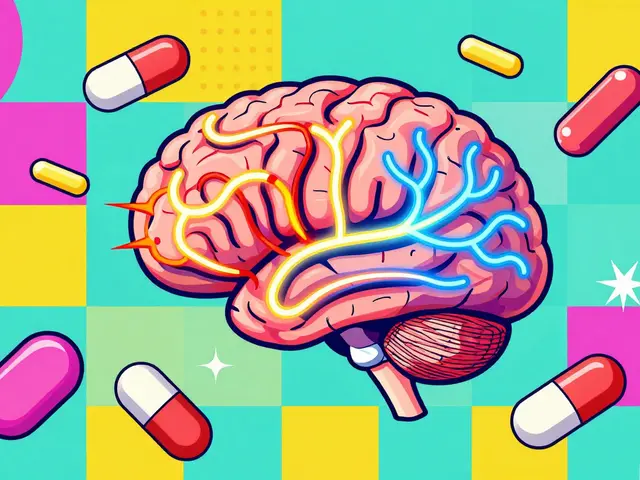Safe Sodium Correction Calculator
Clinically Safe Sodium Correction Guidelines
Based on current medical guidelines:
- Max 6 mmol/L increase in first 24 hours for severe hyponatremia (<120 mmol/L)
- Max 4-8 mmol/L increase in first 24 hours for moderate cases
- Never exceed 8 mmol/L in first 24 hours
- Prevent osmotic demyelination syndrome (ODS) with controlled correction
Calculate Safe Correction Rate
Results
Key Clinical Notes
- Correction rate should never exceed 6 mmol/L in first 24 hours for severe cases (<120 mmol/L)
- Rapid correction (>8 mmol/L/24h) risks osmotic demyelination syndrome (ODS)
- Monitor sodium every 2-4 hours during correction
- Use 3% hypertonic saline only for severe symptoms (seizures/coma)
When a new prescription lands on the pharmacy counter, most people focus on the intended benefit and overlook a hidden danger: a sudden, severe drop in blood sodium. This condition, known as Hyponatremia is a dangerously low level of sodium in the blood, typically below 135 mmol/L, can turn confusion into seizures within hours if a medication pushes sodium too low. Understanding how medication-induced hyponatremia develops, who’s most at risk, and what to do when it strikes can literally save a life.
How Certain Drugs Tip the Sodium Balance
Many medicines interfere with the body’s water‑sodium equilibrium by triggering the Syndrome of inappropriate antidiuretic hormone secretion (SIADH). In SIADH, excess antidiuretic hormone forces the kidneys to retain water, diluting sodium without an actual loss of the electrolyte. The most common culprits are:
- Selective serotonin reuptake inhibitors (SSRIs) - especially sertraline and citalopram.
- Diuretics - thiazide types account for nearly a third of drug‑related cases.
- Carbamazepine and its cousin oxcarbazepine, both antiepileptics that directly stimulate ADH release.
- Other high‑risk agents such as ACE inhibitors, COX‑2 inhibitors, and even recreational MDMA.
These drugs don’t usually cause hyponatremia on their own; the risk spikes when they’re started in older adults, women, or patients already taking another sodium‑affecting medication.
Who Gets It and Why
Data from U.S. hospitals show that about 17‑20% of all hyponatremia admissions are linked to medicines, with the elderly shouldering 61% of severe cases. Women represent 57% of those hospitalized for confusion or seizures caused by low sodium. The typical timeline is short - symptoms often appear within 1‑4 weeks of starting the offending drug, and 73% of severe events surface in the first 30 days.
Red‑Flag Neurological Signs
When sodium plunges below 125 mmol/L, the brain starts to swell. The most common early warning is mental fog or outright confusion (68% of severe cases). If the drop continues past 115 mmol/L, seizures become a real threat, occurring in roughly 22% of patients, and coma can follow quickly. The window between confusion and a seizure can be as narrow as 6‑8 hours, making rapid recognition essential.
Diagnosing the Drop
Laboratory confirmation hinges on measuring Serum sodium. A level under 120 mmol/L flags severe hyponatremia; below 115 mmol/L signals a medical emergency with a mortality rate near 37% if untreated for more than two days. Alongside sodium, clinicians order serum osmolality, urine sodium, and urine osmolality to differentiate SIADH from other causes such as heart failure or renal disease.

Immediate Care: How to Raise Sodium Safely
Rapid correction sounds tempting, but pulling sodium up too fast can crush brain cells, leading to osmotic demyelination syndrome (ODS). ODS shows up in about 9% of cases where correction exceeds 4‑8 mmol/L in the first 24 hours. Most guidelines now advise a maximum rise of 6 mmol/L in the first day for severe cases, followed by a slower pace thereafter. Intravenous hypertonic saline (3% NaCl) is the go‑to for seizures or coma, while oral salt tablets, fluid restriction, and, when SIADH is confirmed, a vasopressin antagonist like Tolvaptan can speed recovery without over‑correction.
Drug‑Specific Strategies
Because each medication class behaves a bit differently, tailored steps help prevent recurrence:
- SSRIs - stop the drug if sodium falls below 125 mmol/L; consider switching to an antidepressant with lower SIADH risk, such as bupropion.
- Diuretics - adjust dose or switch to a potassium‑sparing alternative; ensure regular sodium checks during the first month.
- Carbamazepine - discontinue and replace with levetiracetam or another non‑SIADH antiepileptic when possible.
- Tolvaptan - approved in late 2023 for medication‑induced hyponatremia; use under specialist supervision because it can cause overly rapid correction if not monitored.
Prevention: Monitoring Protocols That Work
Early detection hinges on systematic sodium checks. The American Geriatrics Society recommends measuring baseline sodium before starting a high‑risk drug, then re‑checking at 3‑5‑day intervals for the first month. For patients over 65, the frequency should double, given a 2.7‑fold higher incidence. Embedding these labs into electronic health record alerts has cut missed cases by 38% in pilot programs.

Case Snapshots From the Front Lines
On a Reddit thread in March 2024, a nurse described a 72‑year‑old on sertraline whose sodium slid from 138 to 118 mmol/L within 10 days, culminating in a grand‑mal seizure. The primary care provider had dismissed early nausea and headache as “normal side effects.” After ICU stabilization and a gradual 5‑mmol/L rise over 24 hours, the patient recovered fully, underscoring the danger of overlooking subtle clues.
Conversely, a Mayo Clinic patient portal review highlighted a pharmacist’s alert when a prescription for oxcarbazepine was entered. The pharmacist prompted a baseline sodium test, which stayed normal, and the medication was approved with a follow‑up plan, preventing the sister’s tragic seizure episode.
Future Outlook: AI and Better Alerts
Predictive algorithms are entering the scene. A Mayo Clinic pilot using machine‑learning on EHR data flagged patients at risk for hyponatremia 72 hours before symptoms appeared, achieving 87% accuracy. If such tools become standard, the “window between confusion and seizures” could shrink dramatically, saving lives without extra lab work.
Key Takeaways
- Medication‑induced hyponatremia is a medical emergency; confusion can become seizures within hours.
- Look out for SSRIs, diuretics, carbamazepine, and other high‑risk drugs, especially in older women.
- Confirm serum sodium < 120 mmol/L first; correct slowly (max 6 mmol/L/24 h) to avoid osmotic demyelination.
- Implement sodium monitoring at baseline and every 3‑5 days for the first month of high‑risk therapy.
- Emerging AI tools promise earlier warnings, but clinician vigilance remains the cornerstone of safety.
| Medication Class | Typical Onset (days) | Incidence (% of drug‑related cases) | Key Monitoring Tip |
|---|---|---|---|
| SSRIs | 7‑21 | 22 | Check sodium at day 3, 7, 14 |
| Thiazide Diuretics | 5‑14 | 28 | Baseline + weekly for 4 weeks |
| Carbamazepine / Oxcarbazepine | 10‑30 | 18 | Baseline + bi‑weekly first month |
| ACE Inhibitors | 14‑30 | 5 | Baseline + weekly for 2 weeks |
What serum sodium level defines severe hyponatremia?
Severe hyponatremia is generally defined as a serum sodium concentration below 120 mmol/L. Levels under 115 mmol/L are considered life‑threatening and demand urgent care.
Why do SSRIs cause low sodium?
SSRIs can stimulate the release of antidiuretic hormone, leading to the syndrome of inappropriate antidiuretic hormone secretion (SIADH). The excess hormone makes the kidneys retain water, diluting sodium in the bloodstream.
How quickly should sodium be corrected?
Guidelines recommend a rise of no more than 6 mmol/L in the first 24 hours for severe cases, then a slower increase thereafter. Faster correction raises the risk of osmotic demyelination syndrome.
Can I continue a high‑risk drug after hyponatremia resolves?
It depends on the drug and why you need it. Often the medication must be stopped or switched to a safer alternative. If continuation is essential, close sodium monitoring and dose adjustment are mandatory.
What role does tolvaptan play in treatment?
Tolvaptan is a vasopressin V2‑receptor antagonist that promotes free water excretion without losing sodium. It can speed correction in medication‑induced cases, but requires specialist oversight to avoid over‑correction.
What is osmotic demyelination syndrome?
ODS is a neurological injury where rapid shifts in blood sodium cause myelin damage in the brainstem. Symptoms include dysarthria, dysphagia, and paralysis. Preventing it hinges on slow, controlled sodium correction.



August 11, 2025 AT 06:03 AM
Oh great, another drug that loves to kill your electrolytes.
August 17, 2025 AT 05:06 AM
Behold, the tragic opera of medication‑induced hyponatremia, where our beloved SSRIs and diuretics conspire like treacherous villains in a Shakespearean drama.
First, they masquerade as harmless saviors of mood and blood pressure, only to unleash a silent tsunami of water that dilutes the sodium in our veins.
The elderly, especially women, become the unsuspecting protagonists, their bodies ill‑equipped to battle this unseen assault.
Within a week, a simple headache transforms into a fog of confusion, as the brain swells under the weight of excess fluid.
By the third week, the curtain rises on seizures, the most harrowing act of this medical tragedy.
Doctors, armed with serum sodium tests, must act swiftly, yet with the delicate grace of a maestro, lest they over‑correct and summon the dreadful specter of osmotic demyelination.
Hypertonic saline, that crimson lifeline, must be administered with the precision of a surgeon, raising the sodium by no more than six millimoles per day.
Meanwhile, the humble salt tablet, fluid restriction, and the new star Tolvaptan play supporting roles, each offering a chance at redemption.
But the real hero of this saga is vigilance: baseline labs, periodic checks, and electronic alerts that sound the alarm before the audience even realizes the danger.
When the plot twists towards AI, predictive algorithms whisper warnings three days in advance, turning potential catastrophe into a mere footnote.
Yet, technology alone cannot replace the keen eye of a caring clinician, whose intuition remains the keystone of safety.
Families must be educated, empowered to recognize the early signs of mental fog and nausea, refusing to accept them as mere side effects.
Pharmacists, those unsung gatekeepers, can halt tragedy by flagging high‑risk combinations before the prescription even leaves the counter.
In the end, this drama teaches us that medicine is a double‑edged sword, and only through meticulous monitoring and compassionate care can we ensure the final act ends in triumph rather than tragedy.
August 17, 2025 AT 05:08 AM
i think u r right, the whole thing is serious and i hope doctors keep a close eye on patients. sorry 4 any typos.
August 23, 2025 AT 00:00 AM
Great summary! lots of useful tips for monitoring sodium levels
August 23, 2025 AT 00:01 AM
Thanks! If anyone needs help setting up a simple tracking sheet just let me know.
August 28, 2025 AT 18:53 PM
Monitor sodium early, act safely.
September 3, 2025 AT 13:46 PM
Honestly, this whole hyponatremia hype is just pharma trying to scare us into buying expensive labs.
September 3, 2025 AT 13:48 PM
The stakes are real – I’ve seen patients slip into seizures because a doctor dismissed low sodium as “just a headache.”
September 9, 2025 AT 08:40 AM
Big pharma hides the truth about drugs that mess with ADH – they don’t want us to know how easily they can make us crash.
September 9, 2025 AT 08:41 AM
It’s like a secret society of pills plotting to steal our sodium, and the only way to survive is to stay vigilant and question every prescription.
September 15, 2025 AT 03:33 AM
Hey folks, if you’re starting any of these meds, set a reminder to get your sodium checked – it can save lives.
September 15, 2025 AT 03:35 AM
From a philosophical view, the balance of electrolytes mirrors the balance we seek in life; disturb one, and the entire system falters. Thus, respecting the body’s limits is a moral imperative.